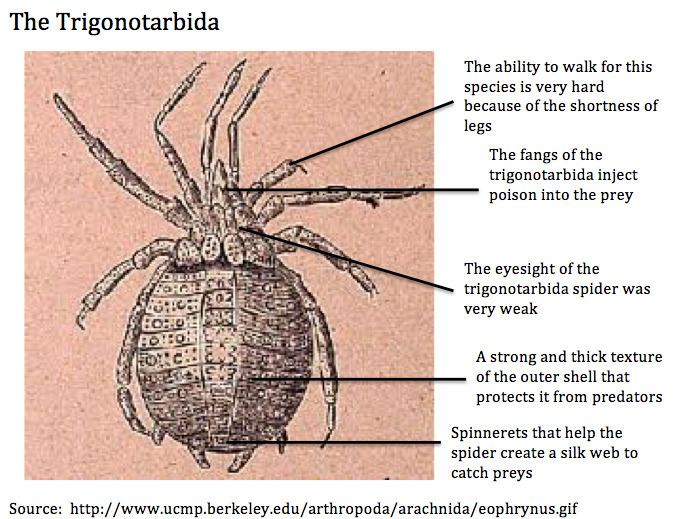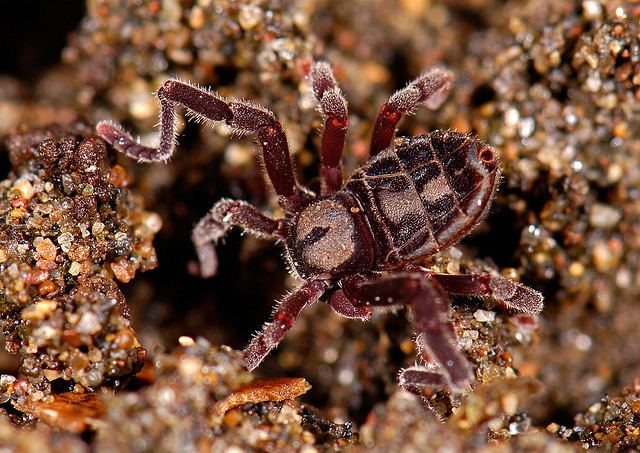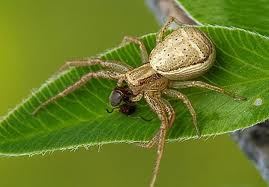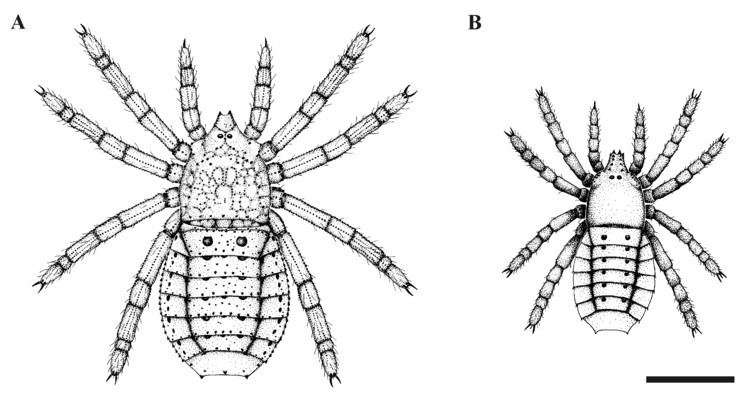Higher classification Arachnid | ||
 | ||
Similar Arachnid, Phalangiotarbi, Plesiosiro, Arthropod, Ricinulei | ||
The order Trigonotarbida is an extinct group of arachnids whose fossil record extends from the late Silurian to the early Permian (c. 419 to 290 million years ago). These animals are known from several localities in Europe and North America, as well as a single record from Argentina. Trigonotarbids can be envisaged as spider-like arachnids, but without silk-producing spinnerets. They ranged in size from a few millimetres to a few centimetres in body length and had segmented abdomens, with the tergites across the backs of the animals' abdomens, which were characteristically divided into three or five separate plates. Probably living as predators on other arthropods, some later trigonotarbid species were quite heavily armoured and protected themselves with spines and tubercles. About seventy species are currently known, with most fossils originating from the Carboniferous coal measures. In July 2014 scientists used computer graphics to re-create a possible walking gait for the animal.
Contents
- Historical background
- A new arachnid order
- Relationships
- Pantetrapulmonata
- Trigonotarbids and ricinuleids
- Internal relationships
- Description
- Prosoma
- Taxonomy
- References

Historical background
The first trigonotarbid was described in 1837 from the coal Measures of Coalbrookdale in England by the famous English geologist Dean William Buckland. He believed it to be a fossil beetle and named it Curculoides prestvicii. A much better preserved example was later discovered from Coseley near Dudley; also in the English West Midlands conurbation. Described in 1871 by Henry Woodward, he correctly identified it as an arachnid and renamed it Eophrynus prestvicii – whereby the genus name comes from ἠώς (eos, meaning 'dawn'), and Phrynus, a genus of living whip spider (Amblypygi). Woodward subsequently described another trigonotarbid, Brachypyge carbonis, from the Coal Measures of Mons in Belgium; although this fossil is only known from the abdomen and was initially mistaken for the back end of a crab.
A new arachnid order

In 1882, the German zoologist Ferdinand Karsch described a number of fossil arachnids from the Coal Measures of Neurode in Silesia (now Poland), including one he named Anthracomartus voelkelianus in honour of Herr Völkel, the foreman of the mine where it was discovered. This species was raised to a new, extinct, arachnid order which Karsch called Anthracomarti. The name is derived from ἄνθραξ (anthrax), the Greek word for coal. A number of other fossils which would eventually be placed in Trigonotarbida were discovered around this time. Hans Bruno Geinitz described Kreischeria wiedei from the Coal Measures of Zwickau in Germany, although he interpreted it as a fossil pseudoscorpion. Johann Kušta described Anthracomartus krejcii from Rakovník in the Czech Republic, and published further descriptions in a number of subsequent papers. In 1884, Samuel Hubbard Scudder described Anthracomartus trilobitus from Fayetteville, Arkansas – the first trigonotarbid from North America.
Relationships

Early studies tended to confuse trigonotarbids with other living or extinct groups of arachnids; particularly harvestmen (Opiliones). Petrunkevitch's division of the trigonotarbids into two, unrelated, orders was noted above. In detail, he divided the arachnids into suborders based on the width of the division between the two parts of the body (the prosoma and opisthosoma). Anthracomartida and another extinct order, Haptopoda, were grouped into a subclass Stethostomata defined by a broad division of the body and downward-hanging mouthparts. Trigonotarbida was placed in its own subclass Soluta and defined as having a division of the body which was variable in width. Petrunkevitch's scheme was largely followed in subsequent studies of fossil arachnids.
Pantetrapulmonata

In the 1980s, Bill Shear and colleagues carried out an important study on well preserved Mid Devonian trigonotarbids from Gilboa, New York. They questioned whether it was appropriate to define a group of animals on a variable character state and carried out the first cladistic analysis of fossil and living arachnids. They showed that trigonotarbids are closely related to a group of arachnids which have gone under various names (Caulogastra, Arachnidea, etc.), but for which the name Tetrapulmonata has become most widespread. Members of the Tetrapulmonata include spiders, whip spiders, whip scorpions and Schizomida and, together with trigonotarbids, share characters like two pairs of book lungs and similar mouthparts with fangs operating rather like a pocket knife. In a 2007 study of arachnid relationships, the Shear et al. hypothesis was largely supported and a group Pantetrapulmonata was proposed which comprises Trigonotarbida + Tetrapulmonata. This has since been corroborated in more recent cladistic analyses.
Trigonotarbids and ricinuleids

In 1892, Ferdinand Karsch suggested that the rare and rather bizarre looking ricinuleids (Ricinulei) were the last living descendants of the trigonotarbids. A similar hypothesis was reintroduced by Dunlop, who pointed out distinct similarities between these arachnid groups. Both have opisthosomal tergites divided into median and lateral plates and both have a complicated coupling mechanism between the prosoma and the opisthosoma which 'locks' the two halves of the body together. Although cladistic analysis has tended to recover ricinuleids in their traditional position closely related to mites and ticks, further discoveries have revealed that the tip of the pedipalp ends in a small claw in both trigonotarbids and ricinuleids.
Internal relationships
The first cladistic analysis of the trigonotarbids was published in 2014. This recovered the families Anthracomartidae, Anthracosironidae, and Eophrynidae as monophyletic. In contrast Trigonotarbidae, Aphantomartidae, Palaeocharinidae, and Kreischeriidae were not. Two clades were consistently recovered with strong support - (Palaeocharinus (Archaeomartidae + Anthracomartidae)), and Lissomartus as sister group the ‘eophrynid assemblage’ (Aphantomartus (Alkenia (Pseudokreischeria (Kreischeria (Eophrynus + Pleophrynus))))).
Description
Trigonotarbids superficially resemble spiders, but can be easily recognised by having tergites on the dorsal side of the abdomen divided into median and lateral plates. This character is shared with ricinuleids (Ricinulei) (see also Relationships). As in other arachnids, the body is divided into a prosoma (or cephalothorax) and opisthosoma (or abdomen). Body length ranges from a couple of millimetres up to about 5 cm (2.0 in).
Prosoma
The prosoma is covered by the carapace and always bears a pair of median eyes. In the probably basal families Palaeocharinidae, Anthracomartidae – and perhaps also Anthracosironidae – there is an additional pair of lateral eye tubercles which, at least in palaeocharinids, appear to have borne a series of individual lenses. In this sense palaeocharinids seem to be in the process of reducing a compound eye.
The chelicerae are of the "pocket-knife" type consisting of a basal segment and a sharp, curving fang. The chelicerae are described as paleognathic: the fangs are held parallel to one another, like those of mesothele and mygalomorph spiders, but the chelicerae hang downwards like those of araneomorph spiders. There is no evidence in well-preserved fossils for the opening of a venom gland, thus trigonotarbids were probably not venomous. The chelicerae may have been slightly retractable into the prosoma. Well preserved palaeocharinids show evidence for a small, slit-like mouth with an upper lip (a labrum or rostrum) and a lower lip (or labium). Inside the mouth there is some sort of filtering system formed from hairs or platelets which strongly suggests that trigonotarbids (like spiders and many other arachnids) could only eat preorally digested, liquified prey.
The pedipalps have the typical arachnid structure with a coxa, trochanter, femur, patella, tibia and tarsus. They are pediform, i.e. they look like small legs and were not modified into pincers. There is no evidence for a special sperm transfer device as in the modified palpal organ of male spiders. Interestingly, in at least the palaeocharinids and anthracomartids the tip of the pedipalp is modified into a small claw formed from the tarsal claw (or apotele) and a projection from the tarsus. As mentioned above, a very similar arrangement is seen at the end of the pedipalp in Ricinulei.
The walking legs again follow the typical arachnid plan with a coxa, trochanter, femur, patella, tibia, metatarsus and tarsus. The coxae surround a single sternum. In well preserved palaeocharinids there is a ring, or annulus, around the trochanter–femur joint which may be the remains of an earlier leg segment. The legs are largely unmodified, although in Anthracosironidae the forelegs are quite large and spiny, presumably to help catch prey. The legs end in three claws, two large ones and a smaller median claw.
